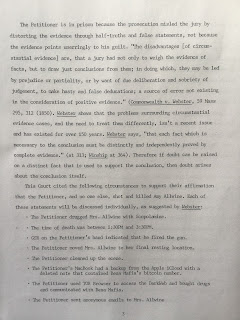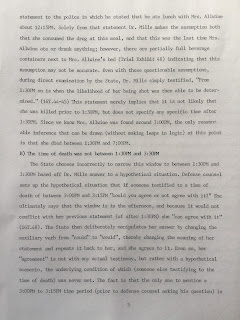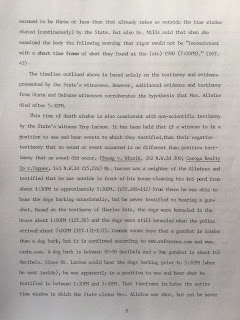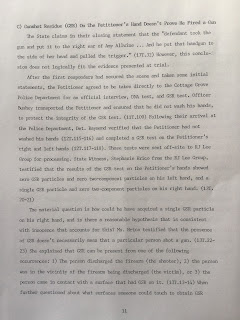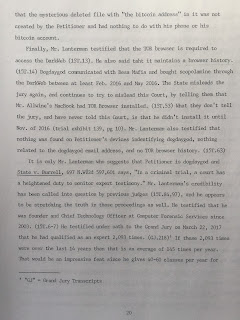Jennifer: You recently submitted a brief to the State on Insufficient Evidence. (see below) Would you like to share why there is a need for you to create a brief like this to submit to the court?
Steve: As you know, it is a complicated case and the State has made a lot of claims in their theory of the case, and they have not been properly addressed. It takes a lot of time and work to unravel them, but I am attempting to do so clearly and concisely using testimony and evidence presented at the trial.
Jennifer: In your brief, you mention that in the past, the Court has “voiced concern regarding convictions based on circumstantial evidence.” Could you expand on this?
Steve: Yes, as I mentioned in the brief, the danger with a case based on circumstantial evidence is that the jury will fill in the gaps and draw unwarranted conclusions. In this brief, I’m requesting that the Court make an independent evaluation of what was presented in court.
Jennifer: You boldly say near the beginning of your brief that you’re in prison because the prosecution misled the jury by distorting the evidence through half-truths and false statements, not because the evidence points unerringly to your guilt. So let’s go through the points you discuss in your brief.
Steve: The Prosecution’s case against me is that I drugged my wife with scopolamine and that I killed her between 1:30 PM and 3:30 PM with the handgun. Then I supposedly moved her body into the bedroom and then cleaned up the scene where she had been shot. Previous to that, I had gone to the dark web, contacted Besa Mafia to hire a hitman, as well as to another site to buy scopolamine. Later, I sent anonymous threatening emails to my wife and then ultimately killed her to avoid a divorce.
Jennifer: OK, let’s start by talking about the drug, scopolamine, found in Amy’s system.
Steve: One of the points I make in the brief is that there was no scopolamine found in the house. If I had purchased it online, it would have had to have been stored and administered somehow. There was no evidence of that presented by the State.
The assumption was made that I gave it to her at lunch at around 12:15 PM. However, the State presented no absorption rates or metabolic rates to support the claim that it took an hour for Amy to absorb the drug. They assumed that Amy didn’t consume anything after lunch, and yet there were partially full beverage containers next to the bed.
Dr. Mills conceded that, "we don't know how much, how often, or when she took the drug."
Jennifer: With it taking about an hour for the scopolamine to absorb, the State concludes that Amy died sometime after 1:30 PM. Am I understanding that correctly? Which would mean sometime during the afternoon while you were still at home.
Steve: The State narrowed the time of death to between 1:30 PM and 3:30 PM based off of an answer to a hypothetical question. Dr. Mills was asked by defense counsel that if someone testified to a time of death between 3:00 PM and 3:15 PM “could you agree or not agree with it?” She said that because it didn’t conflict with her previous statement (of after 1:30 PM) she could agree with it.
That State then turned “could” to “would” and repeated it back to her, changing the meaning of the sentence and she agreed to it.
And, of course, it was all based on a hypothetical question to begin with. Based on the actual medical examiner’s report from that night, the time of death was later, sometime between 5:31 PM and 7:00 PM.
To arrive at this early time of death the prosecution had to lie about when the investigator for the medical examiner's office arrived. They had their witness testify that he arrived around 7:00 PM and stated she had died 4-6 hours earlier, when the crime scene log shows that he actually didn't arrive until 11:31PM, which would mean that 4-6 hours earlier was sometime between 5:31 PM and 7:00 PM, when I got home and called 911.
Jennifer: Since the time of death is critical to your innocence, you cover this thoroughly in your brief. But the jury, alas, was working with a timeline based on a hypothetical question.
Steve: One of the State’s witnesses, a neighbor of ours, was outside cleaning his koi pond from about 1:30 PM to 5:30 PM. He said he could hear dogs barking occasionally, but he never heard a gun shot.
Jennifer: You bring up many things that are significant, such as that another neighbor saw two cars speeding away at around 6:00 PM. You had left the house by then to pick up your son.
Steve: Yes, the prosecution wanted the jury to believe that I had killed Amy before 3:15 PM, that I cleaned the area where it happened, and then left at 5:30 PM to pick up our son. But another neighbor testified that he saw Amy sometime between 3:00 PM and 5:00 PM, alive and in the garage. Our garage door sensors show that the garage was open at around 4:40 PM. So that is not consistent with the State’s timeline.
Jennifer: No, it really destroys their version of events. And you can prove that you left the house at around 5:30 PM?
Steve: Yes, the garage door sensors show the door opening at 5:25 PM. I have a gas station receipt time-stamped 5:42 PM. Later we went to Culver’s and I have a receipt for that, too.
In fact, that's actually never been disputed. Yes, we actually agreed on something. The State acknowledged on the record that departure time and that "his whereabouts are accounted for thereafter.”
Jennifer: One of the things that bothers me is how you follow their instructions, and then are punished for it. I’m talking about how you had a single particle of gunshot residue on you and this is treated as significant. Yet, Amy had significantly more GSR on her. When you called 911, you were told to check her vitals. You did and a single particle likely got transferred to you.
Steve: Furthermore, the evidence shows that there were 3 contributors of DNA on the handgun used to kill Amy. Our son had never handled the gun, both Amy and I had. The third contributor was never established and yet clearly, someone else had also handled the weapon.
Jennifer: The fact that there was an outsider in the house, and likely two based on the fact that two vehicles were seen speeding away, is also shown by how Amy’s body was moved afterwards.
Steve: Yes, the State observed a drip pattern of the blood in the master bedroom, suggesting that at one point Amy was lifted above the carpet. There were other indicators, too, that she had been moved. It was presumed I moved her. But Amy weighed more than I did, and it would have taken two people or someone larger than me to move her.
The police also noted Amy's shirt was pulled up abnormally, but if someone carried her by grabbing her under her shoulder, then this could also account that.
Furthermore, the jury was misled and told there was a washcloth with blood on it found at the crime scene, which creates a mental image of a blood soaked rag.
Jennifer: I read in the brief that, in fact, this was just a cloth that Amy used to clean cuts and scrapes on the dogs. The blood was so minimal that they couldn’t even check whether it was Amy’s blood or canine blood. And in our first conversation, we discussed the footprints in the hallway that were picked up by the luminol lighting, so I’m glad to see you cover that in your brief.
Steve: Yes, I believe they are my footprints, because they are consistent with everything I did when I got home that evening. And in fact, it would be more incriminating if there were no footprints, because on the call with 911 I claimed to have gone to Amy's body twice. To do that I had to walk through the blood residue, from the cleanup area, in the hallway 4 times in my sock feet (to Amy the first time, returning to Joe, returning to Amy to check vitals, and returning to Joe again). Each time my socks would pick up some more of that blood residue, even though I couldn't see it.
If there were no footprints it would be incriminating because either I didn't check on Amy, or I did a cleanup job prior to calling the police." When I gave my first interview to the police, the night she died, I gave details about where I walked in the house when we found Amy. This was before any luminol, and before any pictures. Then the evidence came back and matched my description ... isn't that how it's supposed to work? But rather than that being a good thing the police turn it into a negative.
Jennifer: Yes, you mention in the brief that the physical evidence matches the statement you made to the police. But your case was complicated by the amount of virtual evidence that was presented by the State. Can you tell me more about the bitcoin account that was used to pay for a hitman?
Steve: The State’s expert computer witness lied and told the jury that the address belonged to me. I did have a bitcoin account number, but it wasn’t the one used to pay Besa Mafia. If Mr. Lanterman had taken the time to look at my bitcoin wallet on my Samsung Galaxy phone, he would have seen this. Instead, he stated that he didn’t look at that device because there was nothing of interest on any device other than the MacBook and the iPhone.
Jennifer: This gets featured in the documentaries, the way dogdaygod sent a message to Besa Mafia saying, “My screen refreshed and gave me the wrong bitcoin address where I sent the other funds…it went to…[bitcoin address]”
Steve: Yes, in the transaction, dogdaygod sent bitcoin to that address. So common sense tells us that the address belongs to Besa Mafia and not dogdaygod, and certainly not to me.
Jennifer: The documentaries feature your iPhone which was said to have had a deleted file of the Besa Mafia bitcoin address. They say you deleted if from your phone, but that it was backed up in the cloud. You address that in the brief.
Steve: This is another one of the States' half-truths because there was no evidence of the file on my phone at all.
The file in question had a date and time stamp of March 22, 20216, 9:53 AM. The file appeared in a backup from August 3, 2016, four and a half months later. Since an iPhone backs up when it’s connected to a computer, this would suggest that my iPhone was not plugged into my computer for that length of time!
Also, the State’s computer expert testified that the backup didn’t have to come from a phone with my serial number, only from a phone with the same name and this name could be created by someone else. He also said that he can retrieve deleted items from phones. But there was no trace of this file found on my phone.
Jennifer: I also found it interesting that although you were supposed to have been in contact with Besa Mafia since early 2016 and purchasing scopolamine sometime between February and May, that the TOR browser needed to access the dark web wasn’t installed on your computer until November! And Amy died on November 13th. And nothing to connect you to dogdaygod was ever found on any computer. You also cover the lack of evidence to support that you sent those anonymous emails to Amy.
Steve: Yes, I never denied I had GuerrillaMail. They claimed I used this to send those emails to her. In fact, I was trying to figure out how a scammer had communicated with me.
The State’s computer expert saw click by click and screen by screen documentation of my history there. There was no evidence that I sent anything anonymously to Amy and in the end, even the FBI indicated that these emails came from elsewhere and not GuerrillaMail.
Jennifer: The State had to come up with a motive for you to murder Amy and they claimed that “the defendant intended to kill Amy Allwine because a divorce would hurt him in the eyes of his church.”
Steve: And yet, all testimony was to the contrary. Family and friends all said we were happily married. We had been married for 20 years. We got together regularly with Amy’s parents, about twice a week. Amy’s parents had keys to our house and were free to come and go. We travelled together and when we did, we would all stay in the same house. No one observed any discord.
Jennifer: Yes, police interviewed her closest friends, her colleagues, and her family, and no one said that Amy had confided in them that she was unhappy in her marriage. It’s almost impossible for something that significant not to leak out in some way.
Steve: Amy even had private meetings with an FBI agent assigned to her case. She never confided to him that she was discontent with our relationship or that she suspected me.
Jennifer: In the next interview, we’ll get into the topic of who it might have been who wanted Amy dead.



